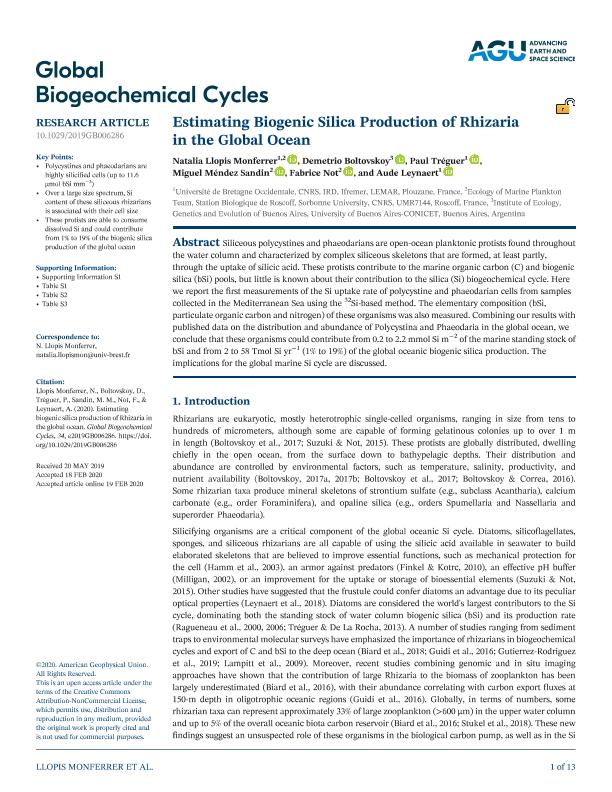Artículo
Estimating biogenic silica production of rhizaria in the global ocean
Llopis Monferrer, Natalia; Boltovskoy, Demetrio ; Treguer, Paul; Mendez Sandin, Miguel; Not, Fabrice; Leynaert, Aude
; Treguer, Paul; Mendez Sandin, Miguel; Not, Fabrice; Leynaert, Aude
 ; Treguer, Paul; Mendez Sandin, Miguel; Not, Fabrice; Leynaert, Aude
; Treguer, Paul; Mendez Sandin, Miguel; Not, Fabrice; Leynaert, Aude
Fecha de publicación:
03/2020
Editorial:
American Geophysical Union
Revista:
Global Biogeochemical Cycles
ISSN:
0886-6236
e-ISSN:
1944-9224
Idioma:
Inglés
Tipo de recurso:
Artículo publicado
Clasificación temática:
Resumen
Siliceous polycystines and phaeodarians are open-ocean planktonic protists found throughout the water column and characterized by complex siliceous skeletons that are formed, at least partly, through the uptake of silicic acid. These protists contribute to the marine organic carbon (C) and biogenic silica (bSi) pools, but little is known about their contribution to the silica (Si) biogeochemical cycle. Here we report the first measurements of the Si uptake rate of polycystine and phaeodarian cells from samples collected in the Mediterranean Sea using the 32Si-based method. The elementary composition (bSi, particulate organic carbon and nitrogen) of these organisms was also measured. Combining our results with published data on the distribution and abundance of Polycystina and Phaeodaria in the global ocean, we conclude that these organisms could contribute from 0.2 to 2.2 mmol Si m−2 of the marine standing stock of bSi and from 2 to 58 Tmol Si yr−1 (1% to 19%) of the global oceanic biogenic silica production. The implications for the global marine Si cycle are discussed.
Palabras clave:
Radiolaria
,
Silica cycle
,
Biosilica
,
Oceanography
Archivos asociados
Licencia
Identificadores
Colecciones
Articulos(IEGEBA)
Articulos de INSTITUTO DE ECOLOGIA, GENETICA Y EVOLUCION DE BS. AS
Articulos de INSTITUTO DE ECOLOGIA, GENETICA Y EVOLUCION DE BS. AS
Citación
Llopis Monferrer, Natalia; Boltovskoy, Demetrio; Treguer, Paul; Mendez Sandin, Miguel; Not, Fabrice; et al.; Estimating biogenic silica production of rhizaria in the global ocean; American Geophysical Union; Global Biogeochemical Cycles; 34; 3; 3-2020; 1-13
Compartir
Altmétricas



